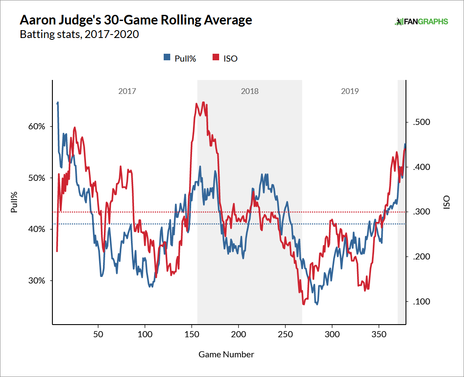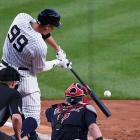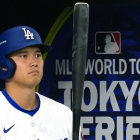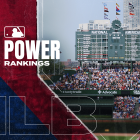
The 2020 MLB season is less than two weeks old and, unfortunately, the headlines are being dominated by COVID-19 outbreaks rather than dingers and pitching performances. Twenty-one members of the Marlins' traveling party, including 18 players, have tested positive within the last two weeks. Seven Cardinals players and six staffers have tested positive as well.
On the field, the 60-game season is roughly 15 percent complete and the "it's still early" doesn't apply like it normal does two weeks into the season. Every game carries that much more importance in a short season. Last week we looked at three big name starting pitchers who are missing velocity in the early going, among other things. Here are three more early season trends.
Judge pulling the ball again
Had the season started on time in March, Yankees slugger Aaron Judge would not have been on the Opening Day roster. He was still dealing with a rib injury in spring training that dated back to last September. In fact, Judge was not given a clean bill of health until right before summer camp. He would have missed most of the first half.
The shutdown gave Judge time to heal and allowed him to avoid missing any regular season games. Through nine games, Judge is 11 for 35 (.314) with six home runs -- he has twice as many homers as singles -- though his five-game homer streak was snapped Monday night. Five of the six homers have given the Yankees the lead, including this go-ahead eighth inning blast Sunday.
"I'm not locked in yet. I'm still trying to find it," Judge said during a conference call Sunday. "That's the daily grind of baseball, searching for that locked in feeling. Locked in for me is if I'm going 5 for 5 every night. I still got out a couple times, chased a couple pitches. So there's some times where I'm not really locked in."
Five of Judge's six home runs this season have been pulled to left field, which is notable. Last year Judge pulled only six of his 27 homers. He really emphasized going the other way for a long portion of the season -- not a bad idea given Yankee Stadium's short right field porch -- and it cost him power at times. At one point he hit only three home runs in a 38-game span.
Defensive shifts have stigmatized pulling the ball but it is still the best way to hit for power. Getting the bat head out early and getting that leverage in your swing is the best way to hit the ball hard. Last year the average exit velocity on pulled batted balls was 90.1 mph. It was 85.9 mph for balls hit the other way. Pulling the ball is the best way to do damage.
Even as big and strong as he is, Judge is no exception to the rule. Throughout his career there's been a clear correlation between his pull rate and his power production as measured by isolated power (isolated power, or ISO, is slugging percentage minus batting average, so it tells us extra bases per at-bat). A graph:

The more Judge pulls the ball, the more power he produces. It's clear as day. That Judge still hit 27 home runs (in 102 games) and led MLB in average exit velocity (96.0 mph, well ahead of runner-up Miguel Sano's 94.4 mph) while posting a 38.7 percent pull rate (the league average was 40.7 percent) last year is a testament to his brute strength. When he makes contact, it is LOUD contact.
New York's season is nine games old and it's too early to say whether Judge has made a conscious change to his approach, or whether this is simply a small sample size fluke. He's put only 23 balls in play, after all. Judge's current 69.9 percent pull rate (fifth highest in baseball) could be down into the more normal 40-50 percent range before the weekend.
For what it's worth, manager Aaron Boone chalked up the pulled home runs and the overall pull happy approach to Judge simply hitting the ball where it's pitched rather than an intended change in approach. Opposing pitchers have been pounding him inside and leaving mistakes out over the plate, and Judge has turned on them in the early going.
"I think he's just put himself into some really good positions to be able to hunt certain pitches in certain situations," Boone said Sunday. "I know it was a storyline last year where all his homers were going the other way but it was never really a big deal to me. I think it's just more a result of the pitches. He's in a good place, being in a good position to handle mistakes."
Judge will not maintain his current 69.9 percent pull rate all season because no hitter does that. The question is whether he can find a balance between last year's extreme opposite field approach -- Judge had a 31.6 percent pull rate in the first half last season -- and his current extreme pull approach. Using the entire field would equal the most dangerous version of Judge.
D-Backs slumping in every way
Coming into the 2020 season, the Diamondbacks were a trendy postseason pick in the National League. It was always unlikely they would unseat the Dodgers atop the NL West, but they have a bona fide superstar in Ketel Marte and a deep position player core, and they added Madison Bumgarner to a solid if not underappreciated rotation. There were reasons to be optimistic.
So much has changed in 11 games. Following Tuesday night's loss to the Astros (HOU 8, ARI 2), the D-Backs are 3-8 with an MLB worst minus-31 run differential. Their preseason postseason odds went from 21.6 percent with the old format to 46.7 percent with the expanded format, according to FanGraphs. Following the 3-8 start, those odds are down to 16.5 percent. Yikes.
"I think the pressing part could be a big part it," starter Merrill Kelly said during a conference call Sunday. "Coming into the year there was a lot of talk about a 60-game sprint and you can't afford to get off on the wrong foot. I think that probably played a part early, but I just think we need to get back to playing our brand of baseball and I think we'll be OK."
As a team the Diamondbacks are hitting .192/.268/.265 with two -- two! -- home runs through 11 games. Players not named Marte (Ketel or Starling) are hitting .162/.236/.222 with one homer. Manager Torey Lovullo has already rearranged his lineup and made aggressive moves (pinch-hitting for David Peralta and Carson Kelly, etc.) in an effort to get the offense going. Nothing's worked.
"I feel like, for what this team has or is capable of, it's going to be a matter of one game or one time through a lineup where we understand how we fit together or how we pass the baton to the next guy," first baseman Christian Walker said over the weekend. "I do believe that when this thing clicks, it's going to be something that's very special."
The pitching hasn't been much better than the offense. Bumgarner's velocity is way down, Robbie Ray hasn't been good, and opponents have stolen 14 bases in 15 attempts against the D-Backs. No other team has allowed more than nine stolen bases and five of those 14 steals led directly to runs. Arizona has consistently let games slip away in the middle innings and allowed their opponent to continue tacking on late. Consider:
- Innings 1-3: 2.40 ERA
- Innings 4-6: 7.80 ERA
- Innings 7-9: 6.23 ERA
At minus-1.6 WAR, the D-Backs have had the worst group of position players in baseball by far this year (Cleveland is second worst at minus-0.2 WAR). Their pitchers are third worst at minus-0.3 WAR. Break WAR down into its components and Arizona has had the worst offense (22.1 runs below average), fourth worst baserunning (1.3 runs below average), and third worst defense (4.0 runs below average). Really hard to win when you've been that bad at everything.
The eighth seed in the National League currently projects to 35 wins in a 60 game season. The D-Backs would need to go 33-16 (a 109-win pace across a full 162-game season) in their final 49 games just to tie. Possible? Sure, it's possible. But this team looked like a legitimate contender coming into the season and now they've dug themselves a big early season hole.
"These are grinding times right now, and these are tests," Lovullo said Sunday. "These are tests for our team and our players. We're going to keep fighting. That's all we know how to do. We're going to grind through these tough times. We know that better days lie ahead. To get there, we've got to accomplish some things piece by piece and day by day. We've got to keep working."
Home-field advantage with empty stadiums
Throughout baseball history, the home team has won 54.1 percent of all games. The home team's winning percentage fluctuates a few percentage points each year because that's baseball, but it's always right around 54.1 percent. Why is this, exactly? There is no one single reason. There are multiple reasons, among them:
- The home team gets the final at-bat.
- Teams typically tailor their roster to their home ballpark.
- Players are more comfortable and better rested at home (in theory).
- The crowd influences play and possibly even umpire's calls (in theory).
Even during this weird season, the first three reasons still exit. The home team still gets the final at-bat, teams are still built for their home ballpark, and I'm certain players are much more comfortable at home than they are on the road during the pandemic. How could they not be? Those reasons aren't going away. (To be fair, regional play makes travel a little easier this year.)
The fourth reason did go away, however. COVID-19 has forced teams to play in empty stadiums, and while teams are playing artificial crowd noise, it's not the same thing. Not even close. You can't replace the organic energy provided by a real, live crowd, and up until this season, we could never isolate the fans' impact on home-field advantage.
Well, two weeks into the spectator-free 2020 season, the home team is 72-65, or a .526 winning percentage. Once again in line with the 54.1 percent historical average. We can look beyond team winning percentage too. Here are the pitcher called strike rates on pitches taken at home and on the road the last five years:
| Called strike rate at home | Called strike rate on the road | |
|---|---|---|
2016 | 31.5 percent | 32.3 percent |
2017 | 31.7 percent | 31.8 percent |
2018 | 31.4 percent | 32.0 percent |
2019 | 30.9 percent | 31.4 percent |
2020 | 31.6 percent | 32.2 percent |
Interesting! From 2016-19, umpires did not show a significant bias toward the home team when calling balls and strikes. If anything, the bias was toward the road team. They received a higher percentage of called strikes -- a very slightly higher percentage, but still a higher percentage -- than the home team. It may happen in certain situations, but, overall, the crowd doesn't influence the ump.
It is not surprising then that the trend continues this year with no crowds. The called strike rates at home and on the road are right in line with previous years. Roughly 31 percent overall, give or take a few tenths of a percentage point. This is a good thing. Umpires are supposed to be impartial and call a fair game. They're also human, and when 40,000 fans are breathing down your neck, it can affect your behavior. It's be silly to pretend otherwise.
Two weeks into the spectator-free season there has been not been a significant change to home-field advantage. The home team is winning at approximately the same rate and umpires are calling balls and strikes at approximately the same rate as well. Does the crowd influence play at times? I'm sure it does. Fans can put pressure on players. By and large though, that impact seems to be small given what we've seen early this year.
![[object Object] Logo](https://sportshub.cbsistatic.com/i/2020/04/22/e9ceb731-8b3f-4c60-98fe-090ab66a2997/screen-shot-2020-04-22-at-11-04-56-am.png)




















